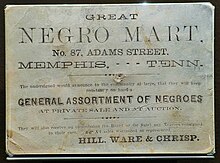User:Jengod/Jail


Forrest's jail was the slave pen owned and operated by Nathan Bedford Forrest in Memphis, Tennessee, United States. Forrest bought 87 Adams Street, located between Second and Third, in 1854.[5] It was located next to a tavern that operated under various names,[5] opposite Hardwick House,[6] and behind the still-extant Episcopal church.[7] He later traded, for fewer than six months, from 89 Adams.[8]
Horatio J. Eden, who was imprisoned there with his mother and siblings in the 1850s, described the building had having "a kind of square stockade of high boards with two-room negro houses around, say, three sides of it and high board fence too high to be scaled on the other side or sides...when an auction was held or buyers came, we were brought out and paraded two by two around a circular brick walk in the center of the stockade. The buyers would stand near by and inspect us as we went by, stop us and examine us."[5]
Forrest sold out of 87 Adams in the summer of 1859 and purchased the building next door, 89 Adams in September.[8] The allowed him to increase his holding capacity from a maximum of 300 slaves to a maximum of 500.[8] In January 1860, the Forrest's spacious new pen at 89 Adams collapsed. According to the Tennessee Baptist newspaper of Nashville, it "gave way and fell to tho ground killing two negroes and injuring four others. The building was three stories high. One of the negroes killed belonged to Mr Thornton of Georgia, and the other to Mr. Brown of Giles county, in this State."[9] The New York Times reported that the Forrest, Jones & Co. negro mart building in Memphis had both collapsed and then caught fire; two people died.[10] The firm's bills of sale for people, "amounting in the aggregate to US$400,000 (equivalent to about $13,564,440 in 2023)" were salvaged.[10] Forrest subsequently sold his interest in the business after the building catastrophe and reinvested the profit into plantations.[8]
In August 1862, after all the Forrest brothers (except for disabled Mexican–American War veteran John Forrest) had all gone off to fight for the Confederacy, their former slave pen became a police station and Memphis city jail.[11][12] At that time the Daily Union Appeal described it as "a filthy den, and would make any decent man sick to be there one night."[13] In spring 1864, after the massacre at Fort Pillow, an article about Forrest's slave-trading business appeared in many Northern papers.[7] The article, said to be written by a "Knoxville correspondent" of the New York Tribune, described whippings at the jail conducted by Bedford and John Forrest, the use of an additional form of torture called salting, and the secret burial of a enslaved man who had been whipped to death with a "trace chain doubled for the purpose of punishment."[7] Forrest's most recent major biographer Jack Hurst described the Knoxville–Tribune report as "inflammatory but in some ways accurate."[14]
In 2018, a historical marker was erected at the former site of Forrest's slave mart in downtown Memphis on land owned by historic Calvary Episcopal Church.[8]
References[edit]
- ^ "The Old Negro Mart". The Commercial Appeal. 1907-01-27. p. 48. Retrieved 2023-12-01.
- ^ Hurst (1993), p. 37.
- ^ "Are we to have a new jail?". Daily Union Appeal. 1862-08-16. p. 3. Retrieved 2023-12-01.
- ^ Hurst, Jack (2011-06-08). Nathan Bedford Forrest: A Biography. Knopf Doubleday Publishing Group. pp. 56–58. ISBN 978-0-307-78914-3.
- ^ a b c Hurst, Jack (1993). Nathan Bedford Forrest: A Biography. New York: Alfred A. Knopf. pp. 37–38. ISBN 978-0-307-78914-3. LCCN 92054383. OCLC 26314678.
- ^ "Removal of the station house". Daily Union Appeal. 1862-08-28. p. 3. Retrieved 2023-12-04.
- ^ a b c "The Butcher Forrest and His Family: All of them Slave Drivers and Woman Whippers". Chicago Tribune. 1864-05-04. p. 3. Retrieved 2023-12-04.
- ^ a b c d e Huebner, Timothy S. (March 2023). "Taking Profits, Making Myths: The Slave Trading Career of Nathan Bedford Forrest". Civil War History. 69 (1): 42–75. doi:10.1353/cwh.2023.0009. ISSN 1533-6271. S2CID 256599213. Project MUSE 879775.
- ^ "On Friday last—". Tennessee Baptist. 1860-01-21. p. 3. Retrieved 2023-12-04.
- ^ a b "A Double Catastrophe in Memphis. A NEGRO MARKET AND A NEWSPAPER OFFICE IN RUINS". The New York Times. January 19, 1860. ISSN 0362-4331. Retrieved May 4, 2023.
- ^ "Removal of the station house". Daily Union Appeal. 1862-08-28. p. 3. Retrieved 2023-12-04.
- ^ "Forrest, negro mart, major general". Memphis Bulletin. 1863-05-31. p. 1. Retrieved 2023-12-04.
- ^ "Are we to have a new jail?". Daily Union Appeal. 1862-08-16. p. 3. Retrieved 2023-12-04.
- ^ Hurst (1993), p. 38.
